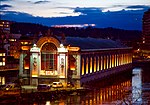Trams in Geneva
1862 establishments in Switzerland600 V DC railway electrificationCross-border rapid transitInterlanguage link template forcing interwiki linksMetre gauge railways in Switzerland ... and 4 more
Tourist attractions in GenevaTown tramway systems by cityTram transport in SwitzerlandTransport in Geneva

The Geneva tramway network (French: Réseau tramway de Genève) is a network of tramways forming the core element of the public transport system in Geneva, Switzerland. It is operated by Transports Publics Genevois (TPG), and is supplemented by the Geneva trolleybus system and the Geneva bus system. Opened in 1862, the network had grown sufficiently by 1920 to serve large parts of the surrounding countryside. However, by 1960 it had contracted to just one line. Since 1995, it has been greatly expanded. It presently has five tram lines, and further expansions are planned. The network extends into France, with line 17 going to Annemasse.
Excerpt from the Wikipedia article Trams in Geneva (License: CC BY-SA 3.0, Authors, Images).Trams in Geneva
Metro Shopping, Geneva Grottes et Saint-Gervais
Geographical coordinates (GPS) Address Nearby Places Show on map
Geographical coordinates (GPS)
| Latitude | Longitude |
|---|---|
| N 46.210277777778 ° | E 6.1433333333333 ° |
Address
Hertz
Metro Shopping
1201 Geneva, Grottes et Saint-Gervais
Geneva, Switzerland
Open on Google Maps









